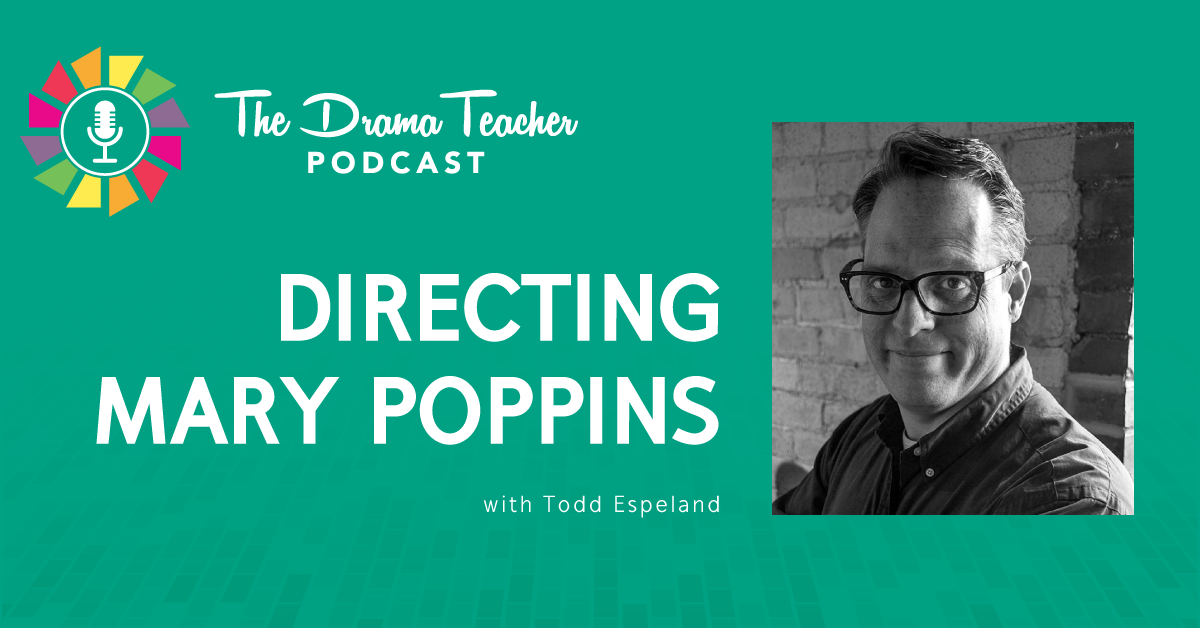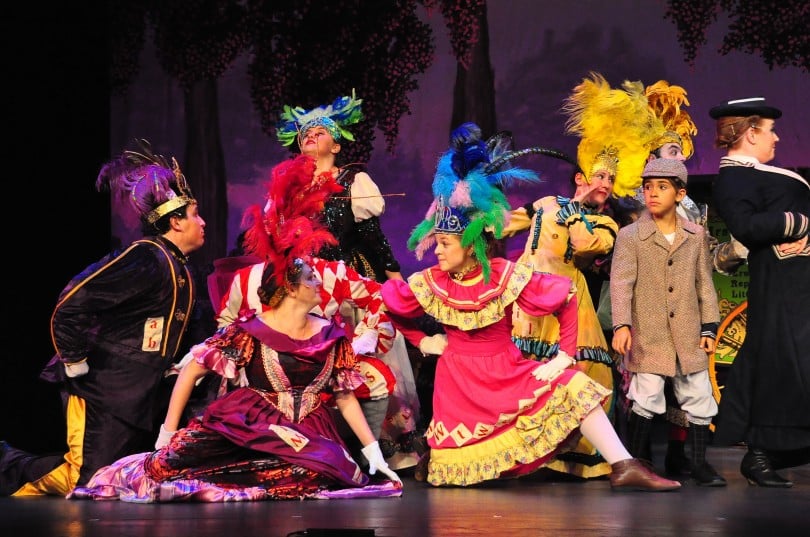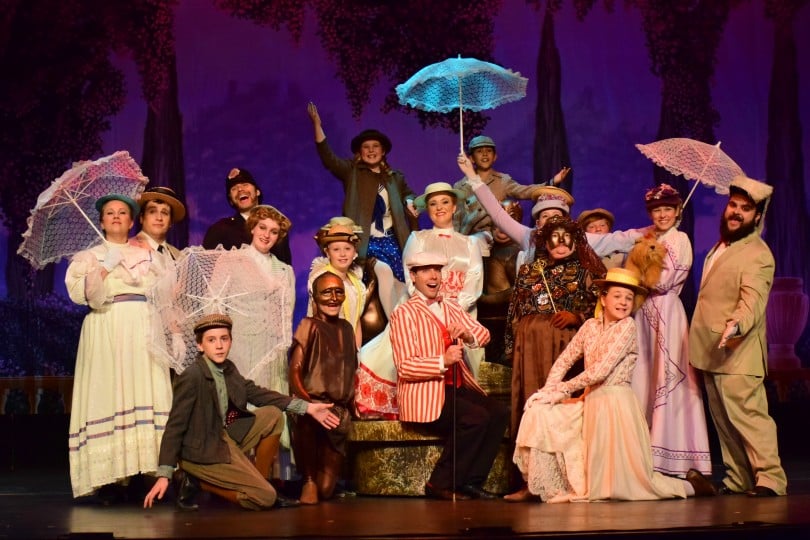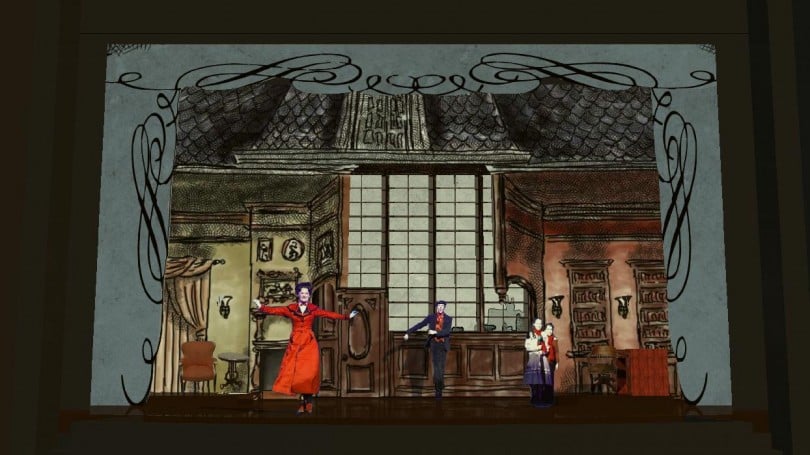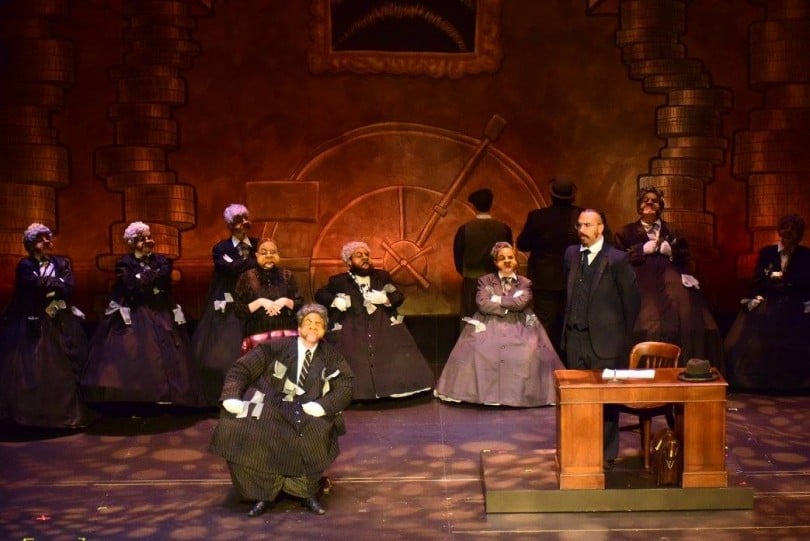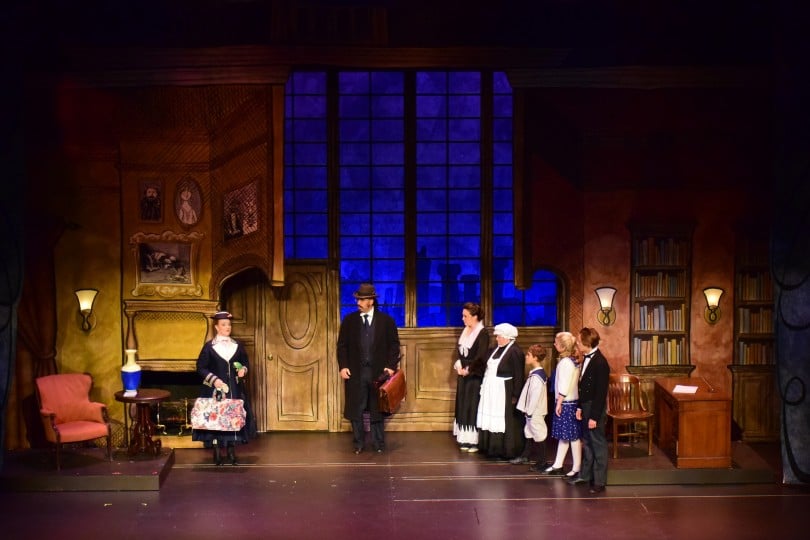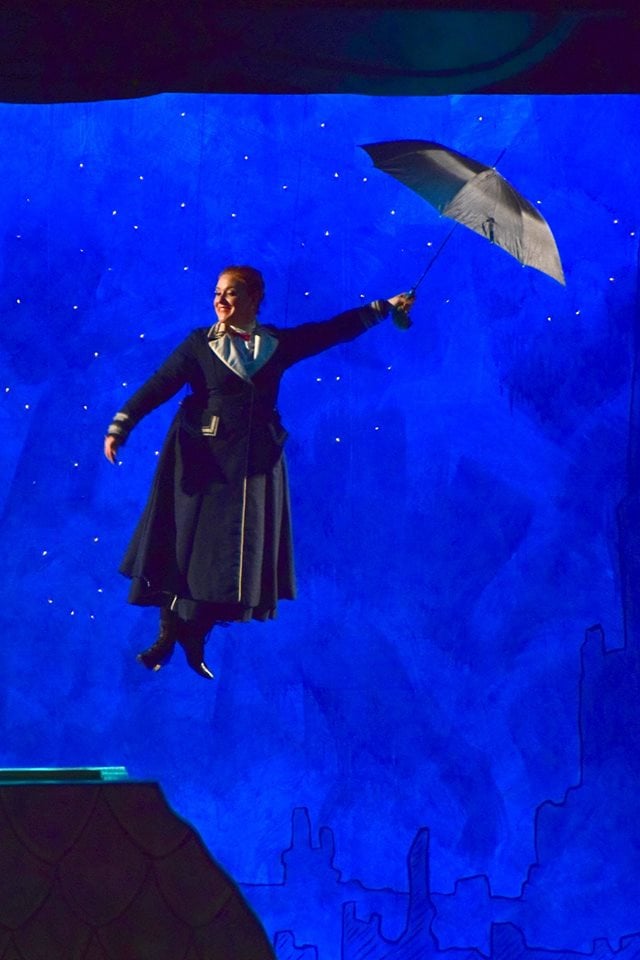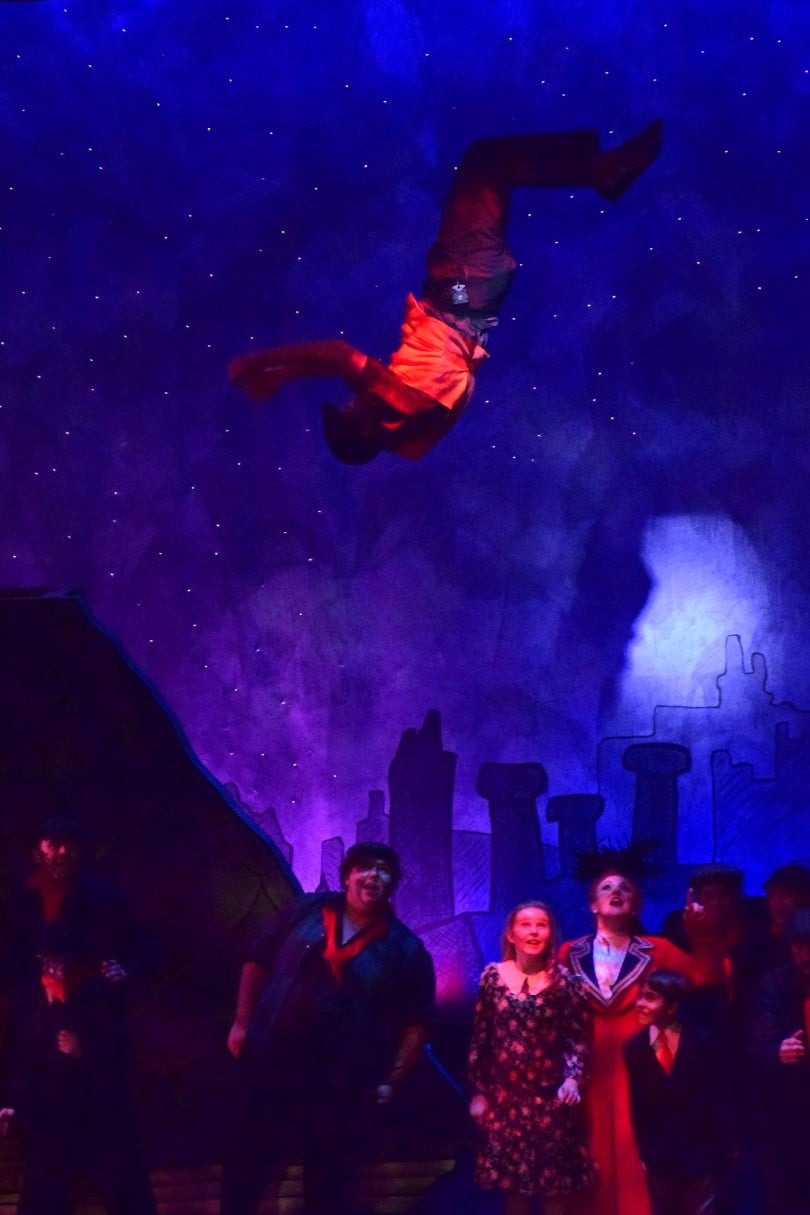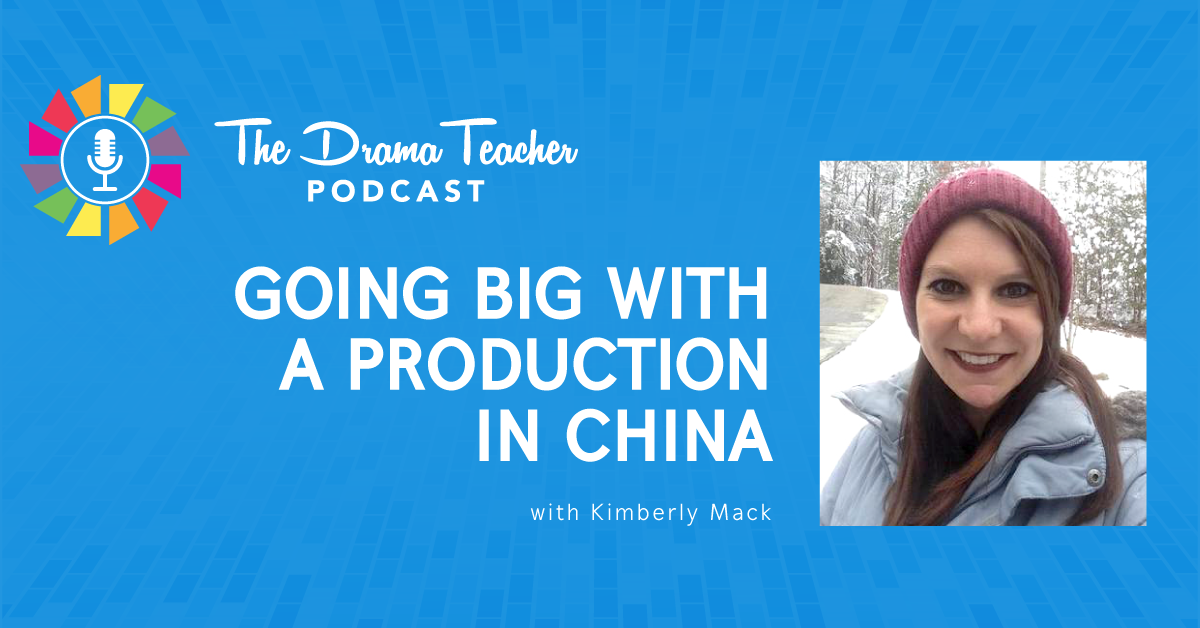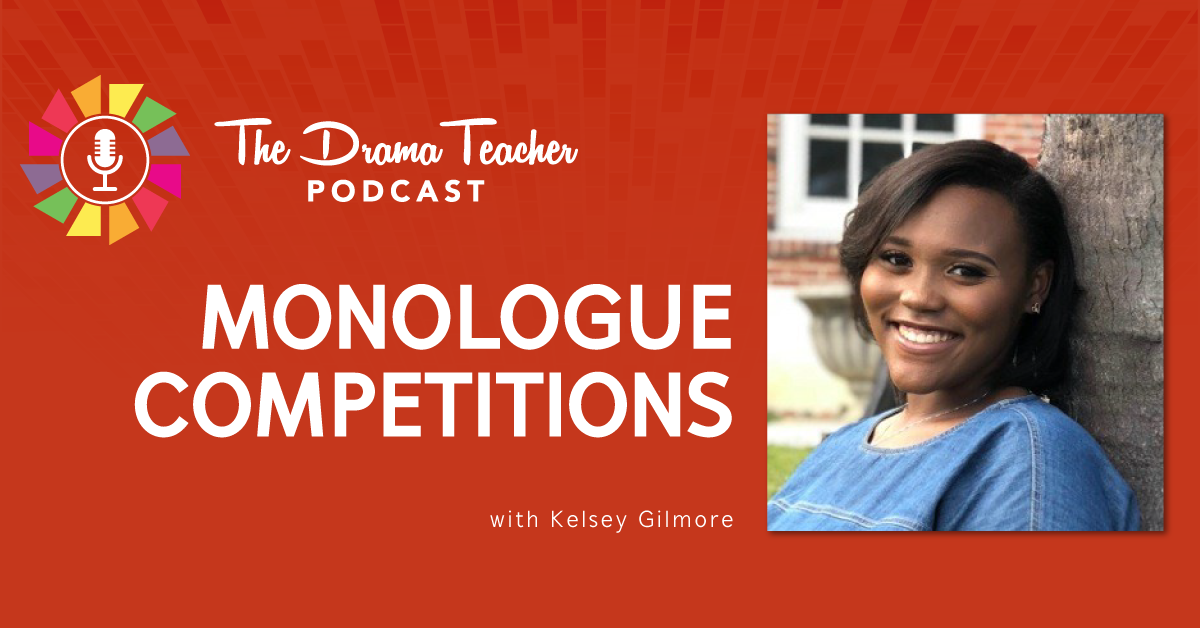Directing Mary Poppins
Episode 153: Directing Mary Poppins
Artistic Director of the Kalamazoo Civic Theatre Todd Espeland directed the musical Mary Poppins last fall. How did put his own stamp on the musical? How did he handle the flying? Todd talks about having a unique vision with the piece without ignoring the show’s iconic nature. Listen in to this one on one look at directing a specific piece.
Show Notes
- Kalamazoo Civic Theatre
- Edward Gorey – The Gashlycrumb Tinies
- Photos by Photo by Fred Western
Images are courtesy of the Kalamazoo Civic Theatre. All photos by Fred Western.
Episode Transcript
Welcome to TFP – The Theatrefolk Podcast – the place to be for Drama teachers, Drama students, and theatre educators everywhere.
I’m Lindsay Price, resident playwright for Theatrefolk.
Hello! I hope you’re well. Thanks for listening!
This is Episode 153.
You can find any links to this episode in the show notes which are at theatrefolk.com/episode153.
All righty. Today’s conversation is an absolute delight. I get to talk to one of my favorite theatre artists who is not only a great teacher, a director, a mask maker, a physical performer – the list goes on and on and on.
Todd Espeland is the artistic director of the Kalamazoo Civic Theatre and recently directed Mary Poppins so we’re going to talk about it. How did he put his own stamp on the musical? How did he handle the flying? Let’s find out in this one-on-one look at directing a specific musical. Wee! I can’t wait!
LINDSAY: Today, I am talking to Todd Espeland.
Hello, Todd!
TODD: Hello!
LINDSAY: Hello, the one, the only!
Todd is currently the artistic director of the…
TODD: Kalamazoo Civic Theatre.
LINDSAY: Awesome. I didn’t quite remember that name. Very good catch! I was like, “I think there’s a ‘civic’ in there somewhere.” Yes.
TODD: Kalamazoo Civic Theatre. It’s 87 years old. It’s the third-biggest community theatre in the country. We do 13 shows a year.
LINDSAY: Which is amazing.
The reason that I am talking to Todd today is that he just completed a very successful run. How many times was the show held over? Twice?
TODD: We held it over twice for a total of 20 performances.
LINDSAY: And they just finished a very successful run on Mary Poppins.
Now, I know that some of our listeners, at your schools you are doing Mary Poppins. Mary Poppins is insanely popular in the high school circuit right now.
TODD: It’s insanely popular everywhere right now.
LINDSAY: And there’s lots of reasons for that, right?
TODD: Oh, yeah. I think it’s a really good show. You know, I had some doubts going into it, directing it. Looking over the script, I thought, “Wow! It’s really well done. I think it’s really smartly plotted,” and what’s nice is it’s not an exact copy of the film. Cameron Mackintosh and Julian Fellows who was the writer for Down Abbey, the creator of Down Abbey, they wanted to take stuff from the movie and the books and kind of concoct a whole new experience that was familiar but different – different enough to keep you engaged.
LINDSAY: I think that’s a really good point and the reason that we’re talking today is that what sometimes happens in some community theatres and some high schools is that they see a show, they want to bring it in, they want to do it, and what ends up happening is they copy and they copy the production that has the most acclaim – like, with the Broadway production – and that is not great, right?
TODD: It’s problematic because, well, it’s problematic because you’re trying to copy somebody else’s vision and, more importantly, somebody else’s technical abilities to get something done and, with just a little bit of forethought, I think you can concoct something that’s new and different and very specific to you as a department or a production company.
LINDSAY: Fantastic!
So, let’s start where you started. When you started looking at the script, what were your thoughts?
TODD: Well, my first thought was it was probably one of the biggest shows I’ve ever directed. So, my first thought was it’s problematic and that it’s so huge and epic that it can get away from you. You know, there’s all these big numbers and my thought was the first thing I had to nail down was what was the core of the story? What was the story really about? Because you’ve got these great numbers and Supercalifragilistic and Step in Time and they’re huge and they’re boisterous. But what’s really going on in the play?
For me, what was really going on in the play is it’s called Mary Poppins but it’s actually the story of the Banks family. They’re an incredibly dysfunctional family. The father is only focused on making money and being “the perfect provider.” The mother is focused on being the best wife possible. The kids are dying for attention – that’s half the reason why they’re driving the nannies out of the house and driving the nannies crazy.
Mary Poppins enters into this and she’s there to sort of teach them what it’s like to be an empathetic and caring family – you know, what it’s like to care and love each other and pay attention to each other.
For me, it was stripping away all of the big shiny stuff and just going, “At the end of the day, what’s the story really about?” and it was that.
And then, the other thing that the story was really about for me was the song Feed the Birds. It was Disney’s favorite song. It was Disney’s favorite piece from the movie. Looking at it and saying, “How is Feed the Birds? How is this idea of taking a very small effort on your part of empathy and caring, how that translates into something very meaningful for people who need that empathy and need that caring and kind of push those two things together and that gave me the core of the story I was trying to tell?” Then, we could look at all the big numbers and the big flashy things and see how those fit in.
LINDSAY: I think that’s a really important point for anybody doing musicals – that it is really easy to get up in the flashy. It’s so easy to get caught up in the musical numbers and to forget that you are a director and that you need a vision for this beyond the flashy. You need to start.
TODD: You’re being a storyteller. You know, what story are you telling? I think that’s a good place to start – not even just with musicals. I think with any play, it’s easy for us, if you’re doing Shakespeare with your students, if you’re doing Neil Simon, what’s the story that you’re trying to tell and then what are all the other things that the playwright or the producers have put around that story to keep you engaged or to back up that story?
LINDSAY: Going from your core thought about this is about the family, what are some visuals, what are some aspects that you used to communicate that vision?
TODD: My second thought after I kind of came to that decision was, visually, because I trained in physical theatre, I trained at a place called the Dell’Arte International School of Physical Theatre so visuals are very important for me – not visuals that are empty so that things look pretty but how are you also visually telling the story? Because audiences remember more of what they’ve seen than what they hear. How can you back up what you’re doing visually?
The first thing I thought was, because the theatre I’m working at has a very large patron base and I don’t want to go too crazy wacky, my first thought was, how do we maintain this vision that Walt Disney had for the story? And then, I thought, what contrasts with that? What is contrasting this kind of happy, up, technicolor, wonderful, beautiful world that Disney was envisioning? And so, I tried to think of something that would counterbalance that and there’s an author and an illustrator named Edward Gorey and he did a thing called Amphigorey. He also did, if you paid attention to PBS in the 70’s and 80’s, he did the titles for the mystery television show that they had, PBS Mysteries. His cartoon style is a very black and white cartoony style – I want to say lines but it sounds so ridiculous…
LINDSAY: You know, we’ll put something in the show notes.
TODD: Okay.
LINDSAY: We’ll give a visual.
TODD: Okay. So, I wanted to use Edward Gorey because the stuff he does is cartoony and it’s light and it’s fun but, when you look closely at it, there’s a darkness to it. Like, he has a thing in Amphigorey called The Gashlycrumb Tinies. It’s basically the ABCs and all of the pictures are of a child being killed in some ghastly way. My favorite one is N – “N is for Neville who died of ennui” – and the picture is this little boy – you know, you can see the top of his eyes looking out this window and he looks so sad. I know it sounds gruesome but it’s really funny.
And so, my thought was, how can we use this sort of light, airy cartoon style that Edward Gorey had but there’s a darkness to it and then combine that through lighting and other things to kind of get that technicolor Walt Disney. So, the play really moves from this sort of dark Edward Gorey look and ends in this sort of happy technicolor Disney.
LINDSAY: Transformation.
TODD: Yeah, and the lovely part about it was we incorporated that through all of the sets. The way the houses were done, they were actually drops. The kitchen, they were drops. There was actually a scrollwork framework that framed the stage so it looked like a panel from a children’s book from around the turn of the century. All of that was done in this Edward Gorey sort of style. And then, our lighting designer, she really ran with this sort of technicolor Disney look and we had lots of rich saturated colors all over the stage and lighting costumes. When we did Jolly Holiday and all of the holiday people when Mary transforms the park and the kids go into this magical park, the costumes that people were wearing were more browns and whites so that, when we hit them with light, we could really saturate them with different kinds of light because they were mostly light browns or whites, and then we could also light them with just front light and they would pop and stand out. It was really a way to transform all of these magical places that Mary takes the kids to teach them lessons and have a counterbalance with what’s going on at their homes.
LINDSAY: See, something like that, all I can think of is how much fun it is to establish your own take, your own vision, and then, just as you say, the lighting person ran with it, and just to keep things. It’s important to acknowledge a specific world. I know a set designer or a costume designer and their big thing was, if you are dealing with something iconic, you have to decide if you are going to honor that iconic nature and you have to think of your audience just as you’re like, it wouldn’t have been good on your audience if you had went, like, deep dark Mary Poppins.
TODD: Exactly. I mean, you could, but especially because this was also our Christmas show.
LINDSAY: It’s a whole new look of Christmas.
TODD: Yeah, you have to consider, like, when you’re doing it. I know, at a school, you kind of have this is the time of year when you do the play, this is the time when you do the musical, but you kind of have to keep in mind what’s the purpose of you doing the musical or the time of year you’re doing it.
The other thing that I did was I kind of looked at, because I actually took a class in children’s literature and it was actually really helpful and fun. I took it for fun and I thought it was an interesting way to kind of explore storytelling and I looked at how I could apply it to what I did as a director and one of the things that children’s literature does is it’s there to kind of teach and impart values of a society and Mary Poppins is a children’s book. For better or for worse, P. L. Travers was trying to instil her own set of beliefs and morals in readers through this book. And so, when I looked at it through that lens, every place that Mary takes the kids, everything she does with the kids is some kind of lesson that the kinds learn so they can ultimately learn how to feed the birds and how they can learn to be empathetic and loving and think of other people than themselves.
LINDSAY: The character of Mary Poppins in the book is very much a teacher.
TODD: Oh, absolutely.
LINDSAY: She’s an instructor.
TODD: Yeah, and that’s what she does. She takes these kids to all these crazy places and then they learn a lesson and they go home and then they have this experience at home and then they go out and then they learn a lesson then they bring it back into the house and that kind of starts changing their mother and father a little bit. And so, it helped to also look at each of these compartmental elements in the play and it was actually kind of nice because I had this overarching story and then each of the little events in the story has its own beginning, middle, and end, and it should have its own sort of look and feel and approach so that these kids are going to all these crazy different places.
LINDSAY: Yeah. Can you give an example of how you did that with one of the stories?
TODD: Actually, I’ll give you two because the second one was totally remarkable.
The first one was when the kids go to the bank. Mary Poppins take them to the bank that the father works at. The song that the bankers sing goes, “Precision and order, cogs in a wheel,” and it has a march tone to it and it’s very vocative of being cogs in a wheel and kind of that Warner Bros song that goes “dun dun dun dununununt da” – it has that to it. So, one of the things I wanted to do was make the bankers sort of a human machine. You know that improv game that you play where you build a machine – one person does a move and it feeds the next person and you’re this human machine? I played that game with the bankers and we created this sort of… We just brainstormed different things that you would do at a bank that would be repetitive and then we built this machine out of them. You know, they became this paper-passing, stamping machine.
The other thing I did was they’re not really real characters. They’re not real three-dimensional people the way the rest of the characters in Mary Poppins are and my background and my training is in mask and movement theatre so I decided I was going to mask the bankers and my costume designers ran with that. They were these big kind of fat pudgy, you know, gross sort of fat guy masks and she ran with that so the costumes for the bankers were actually hoop skirts that people tied just under their armpits and then the costumes looked huge. They were at their base – about five feet wide at their base. And then, we put these big white wigs on them and she had money just poking out of their pockets and stuff and the chairman, she happened to have this giant suit – I don’t know why she has this giant suit but it was this giant suit that was all rhinestoned that was in some sort of opera that she got at a sale in the theatre. I mean, it was absolutely huge.
We put the chairman in this big giant suit with a big giant three-piece suit on him and I had him in this giant office chair the whole time because he’s the chairman and his office assistant, Miss Smythe, just rolled him around on the stage; he never walked on his own. We just sort of turned him into this big kind of comical, grotesque, money-grubbing group of bankers.
It was really fun to do and it was cartoony and it was fun and it fit the style of the play and the story, the kind of children’s story of it, and a lot of my colleagues at the Civic were a little doubtful of this. They were going with it but they were like, “Um, okay…” and I was sitting in tech with the lighting designer and she looked over at me and I’m not saying this to pat myself on the back. She just looked over at me and she goes, “This is brilliant,” when the bankers were on and I went, “Why? What do you mean?” She said, “It’s just brilliant. You made the whole point about banking and greed and the lesson that George Banks needs to learn and you didn’t hit us over the head with it and it’s actually kind of big and funny because masks require this big sort of large physicality.” She said it absolutely worked. It was super fun to do. It was really, really fun. I liked it.
The other thing that we did was with Supercalifragilistic. I have a training in Commedia dell’arte and I wanted to make all of the people who were at the talk shop, I wanted them to be this Commedia dell’arte troop and have these big bright colorful costumes on and we happened to have a wagon that was left over from The Wizard of Oz, Dr. Marvel’s wagon or Mr. Marvel’s wagon. And so, we had that wagon with letters all over it and the costume designer took all these bright sort of Commedia dell’arte-esque costumes and I said I wanted everything to be made out of letters and so she sewed giant letters and tiny letters all over them to make them look like the costumes were also constructed of letters and then, weirdly enough, we got a donation at the theatre from one of our patrons. She donated 40 carnival masks from Brazil or carnival headpieces, headdresses from Brazil, and they’re these giant feather headdresses and she donated them to the theatre and they fit perfectly with what we were doing with Supercal and we were like, “We’re totally running with this. This is an accident. We didn’t plan on it. We’re totally running with it,” and it made Supercalifragilistic this fun kind of Mardi Gras carnival sort of a number. It just built on my idea about Commedia dell’arte and these big bright costumes and then we had some goofy happenstance happen. You know, it was really remarkable.
LINDSAY: It just sounds like, well, the whole notion of Supercal being a Mardi Gras party, that image is, well, it’s quite remarkable, isn’t it?
My favorite part of this conversation is “and then they ran with it” because I just love the idea of people getting to do what they love and being able to creatively express in a piece that is certainly not antiquated but it’s set, right? A lot of people would think that Mary Poppins is set and that you have to do it the way that it’s done because it’s iconic, because it’s the way that it’s always been done.
TODD: And why question it?
LINDSAY: And why question it?
TODD: Yeah.
LINDSAY: And maybe they like it. You know, there’s lots of people who do that copy because they want to be in that copy and they want to and it’s hard to get across to those folks that that’s not theatre. That’s not being theatrical and a part of being theatrical is you and your mind.
TODD: Here’s another thing that happened. Sorry, I don’t mean to interrupt.
LINDSAY: Oh, you go.
TODD: This is another crazy thing that happened. My choreographer is Kathy Williams. She’s choreographed here in Kalamazoo for a long time – at least 25 years. She’s a really funny, wonderful woman. She teaches at the local university in the dance department and she’s done a lot of shows here and I was a little intimidated about working with her because I’m fairly new at the Civic and she’s been around a while and she was just a joy to work with. Well, I came in and I was blocking Supercal and all the talky stuff and I taught this thing called the Poses of Arlecchino. Arlecchino is this trickster servant in the Commedia and he has sort of a prescribed way that he moves and there are these five different moves that sort of make up this character and I taught them to all of the actors because I thought it would give them a fun basis and a real physical style and look to the way they were going to move in this scene and I taught all five of them and she just loved it. She was eating it up. She was writing it all down and we got into her choreographing the number and she scrapped about a third of what she was going to do and adapted in the poses of Arlecchino into the number and how she wanted the people to move. She loved what I was doing and she was inspired by it and she just sort of ran with it and, like, literally, trashed a third of what she had planned in the moment because she liked what was going on.
LINDSAY: Well, I think that’s cool. That’s collaboration.
TODD: Yeah.
LINDSAY: That’s teamwork, you know.
TODD: And she was willing to let go of her idea of how Mary Poppins should be or how this number should be when she saw something that was working for her.
LINDSAY: Yes! That’s exactly how it should go!
How did you handle the flying?
TODD: We did the flying, we brought in Flying by Foy – it’s a company out of Las Vegas that basically invented stage flying. They invented a system of flying for Peter Pan back in the 60’s and they’ve been doing it for a very long time and we decided to go with Flying by Foy. There’s another company in Louisville, Kentucky, called CFX and I inquired with them about what they did for flying and basically went with Foy because we worked with Foy a little bit more and they were going to bring somebody in who’s worked at our theatre before so we went with Flying by Foy.
Foy has three different packages. They have a simple system where you get one track and you can hook up either person to the track. Basically, what it is is it’s a track that is above your theatre in your fly space and it’s a system of wires that the flyer is hooked up to and there’s one rope that moves them up and down and one rope that moves them back and forth. There’s other systems. There’s a thing called a pendulum system which I don’t know a lot about but, for Mary Poppins, she just used the track systems and the people flying wear this kind of leather harness and the wires get hooked up to the sides of their harness – kind of around where your hip bones are.
So, you can get one track which is the cheapest; you can get two tracks which we went with; and then, you can get the super duper system where Bert can tap dance on your proscenium arch. He can stand at a 90-degree on the proscenium arch and tap dance. It’s expensive. In our theatre, we have a great proscenium arch but because our proscenium was made in 1931 and the adjustments that were done to it to accommodate a fire curtain and things like that wouldn’t allow Bert to tap on it so we scrapped that and we had the flying guy came in. They ship the equipment to your theatre and then you get your flying coach.
Our flying coach was a wonderful man named Geddy Webb. Your flying coach comes in and the first day, he hooks up all the stuff, and at night in rehearsal, you just work with the people flying and it’s real simple. They just lift you up and lift you down and you have people that are there who are going to take care of the flying. Like, you have crew members who handle the flying and he teaches them how to lift and move the person and they just get used to doing it and then it’s just like a regular blocking rehearsal.
You tell the flying coach what you want and he gives you his expertise about how to make it happen and then you roughly block it in and it’s done very slow and easy so that your flyers get used to it. And then, the second night, he’ll be there and you can go a little faster and perfect the flying a little bit more and he basically makes sure that the people flying are comfortable with what’s happening and he makes sure especially that your people who are your flying team that they’re comfortable flying the people – lifting and flying the people who are being flown. But they were great.
It was really wonderful and I actually did something kind of kooky with Bert in Step in Time. There’s a point in the number where Bert’s supposed to fly above everybody and I did something that is not usually done. Usually, if you can’t have Bert tap dance on the proscenium, then what you do is they have an extra giant chimney and Bert will come out and just walk out and he’ll put one foot on the chimney and then he’ll put the other foot on the chimney like he’s at a 90-degree angle and then he’ll walk up the chimney, up to the top of it and then he’ll jump off the top of the chimney and fly and do some flips and it doesn’t last very long. He’ll do some flips stage left to stage right and then back the other way and then he’s done and then the rest of the number happens. I decided I wanted to have Bert walk on the chimney sweep brooms so that he would step on one of the brooms and it would look like the chimney sweeps are lifting him and him standing on the broom and then he would step out and somebody would put a broom under his foot and he would walk across the stage walking on these brooms and then he would leap off the brooms and do the flips. Geddy was really accommodating with my idea. He was a little doubtful of it but he wanted to make it work and we were able to make it work and he was great about it and they were very easy and friendly and incredibly accommodating and easy to deal with.
LINDSAY: I think the bottom-line in all this is get a company who knows what they’re doing.
TODD: Do not do it on your own. Oh, my god – please, do not do it on your own.
LINDSAY: No, don’t do it on your own and, if you can’t afford it, don’t do it on your own.
TODD: Yeah, if you can’t afford it then you should try and find other ways to make it happen – the flying and try to create that sense of magic. There was a production that my stage manager did in the summer of Mary Poppins because everybody’s doing it. The concept of that show, it was in a barren theatre in Pennsylvania and they didn’t have the ability. Like, they just didn’t have the room to have the flight equipment. And so, the director’s concept was the chimney sweeps created all the magic in the show. In Spoonful of Sugar, when the kitchen falls apart, the chimney sweeps are actually standing and one guy is holding two cabinet doors and pretending to be a cabinet and somebody’s holding a sink or a thing that looks like a sink and pretending to be the sink. And so, when Bert flew, he didn’t fly. The chimney sweeps lifted him and they had him doing some circus lifts in order to make Bert look like he was flying. They found a really elegant and sort of wonderful imaginative way to accomplish the flying. It wasn’t that they couldn’t afford it. They just literally didn’t have the infrastructure to support that and, you know, you might be in that place and so it behoves you to try and figure out a way to use the magic of theatre and the magic of pretend to make that happen.
LINDSAY: Well, your audience is going to go with what you do. If you set up a world where chimney sweeps are magic, nobody has to fly because, if chimney sweeps are magic, then you just buy it and you will go with anything that happens and that’s way better than a really crappy half-done sort of flying Mary when we all know it’s fake.
TODD: Right.
LINDSAY: I’d so much rather see a kitchen fall apart done by chimney sweeps than anything done crappy.
TODD: Oh, absolutely. You know, I’ve seen people do the Mary Poppins flying by having a gobo of Mary move across the cyc and that’s lovely enough and that’s all you really need to do. If you can get the flying and you have the money to spend, awesome, do it! It will be lovely and it will be a memory that everybody will love because they don’t often see it because there is a cost involved. But, if you can imaginatively do it, you’re also going to get a lot of mileage out of that.
LINDSAY: Well, absolutely. I’ve got to wonder, you know, I think there’s going to be just as many people who remember the flying in your show as they remember the bankers.
TODD: Oh, yeah, absolutely.
LINDSAY: Absolutely. Awesome.
As we wrap up here, now that you have this under your belt, what three things would you say to our wonderful listeners who are thinking of tackling a big musical, who might be afraid to tackle a big musical, who are afraid of moving away from the iconic of a big musical?
TODD: The first thing I would say is come up with a visual point. Well, understand what the story is. That’s the first thing I would say. What is the story that you’re doing? What’s the heart of the story? What is all of this flying and bankers and Commedia and all of that – what story is it supporting? That’s the first thing because that’s the most important thing. You’re not doing it to have all the bells and whistles; you’re doing it to tell the story.
The second thing I would say is, visually, how are you supporting that story? What are you doing visually to support that story? I dipped into what I thought people expected a little bit of Mary Poppins in terms of the musical and the I dipped into my imagination in terms of what I appreciate from children’s story because this is a children’s story and I tried to dip into what I personally, as a human being, appreciated about children’s stories and thought, “How does that counterbalance?”
The last thing I would say is, god, actually, the last thing I would say is this – however you design the show, make sure that it’s moving. Make sure that it’s really moving quickly so that, if you are coming up with a set that is going to take you five minutes to break from the open street of London and move into the house of the bank’s house – because that’s what happens, people try and do this giant two-story staircase set – you might want to come up with something different or find a different way to do it because the time that it takes to make all this “magic” happen, if it’s not happening effortlessly, then you’re going to lose the story that’s really at the heart of what you’re trying to do.
LINDSAY: Well, you also lose the audience. You take them away from the world of the play.
TODD: Well, yeah, I mean, that was a real goal of mine because there was a production that happened around the area before ours which was a little bit unfortunate and their show was three hours long because the set changes took a long time. Our production – because I made it of value that we needed to have these go quickly so that it would support the story – our show, without intermission, just total performance time was two hours and fifteen minutes. This other production was three hours and that’s 45 minutes where you’re going to lose people.
LINDSAY: That’s a long time. Oh, my goodness. That’s a lot of set chances, man.
Todd, you are wonderful.
TODD: Lindsay, you are wonderful!
LINDSAY: No, you’re wonderful! Oh, we’re all wonderful!
No, listen, you are a busy, busy man and I manhandled you into sitting down and talking with me because I knew how valuable your little ol’ point of view would be on this topic and I really appreciate it.
TODD: I’m always glad to help out Theatrefolk.
LINDSAY: Sweet! All right, thank you, Todd!
TODD: Thank you!
LINDSAY: Thank you, Todd!
Before we go, let’s do some THEATREFOLK NEWS.
Since we’re talking musicals, I think it’s appropriate to do a shoutout for Theatrefolk’s musical, Shout!
Theatrefolk doesn’t specialize in musicals but we do specialize in experiences. That’s something I love. I love to write and to offer what-if experiences for schools and student performers and shout is an incredibly unique what-if experience in that it is a musical with no orchestration and no tracks. Shout! is an a cappella musical. That’s right, you heard me – just voices.
Now, it was specifically written for student performers. Kristin Gauthier who wrote the music spent time both as a musical theatre performer and as a teacher. She has her feet firmly planted in both worlds. Is it challenging? Yeah, you bet! Is it rewarding? I’d say, “to the moon.” It’s got awesome characters who sing from the heart and I really couldn’t be more proud of this piece.
So, check out Shout!: An a Cappella Musical at theatrefolk.com and in the show notes at theatrefolk.com/episode153.
Finally, where, oh, where can you find this podcast? We post new episodes every second Tuesday at theatrefolk.com and on our Facebook page and Twitter. You can find us on youtube.com/theatrefolk and on the Stitcher app. You can subscribe to TFP on iTunes. All you’ve got to do is search for the word: “Theatrefolk.”
And that’s where we’re going to end. Take care, my friends. Take care.
Music credit:”Ave” by Alex (feat. Morusque) is licensed under a Creative Commons license.
